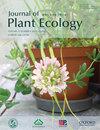亚热带山地森林中藤本植物与共生树木茎叶特征的差异
IF 3.9
2区 环境科学与生态学
Q2 ECOLOGY
引用次数: 0
摘要
由于缺乏性状比较,人们对亚热带山地森林中藤本植物和树木生态策略相关的功能性状变异模式仍然知之甚少。在此,我们通过研究中国西南亚热带山地森林中 33 个物种(7 个落叶和 4 个常绿藤本植物物种,以及 10 个落叶和 12 个常绿乔木物种)的 13 个性状,探讨了不同叶片习性的藤本植物和乔木之间的性状差异,从而填补了这一空白。我们发现,与同域的乔木相比,藤本植物的茎木质部血管直径明显更大,理论水导率、比叶面积、叶片氮和磷浓度都更高,但叶片干物质含量和氮磷比却更低,这表明藤本植物采用了一种获取性生态策略,具有更高效的茎液压系统和更高产的叶片。与乔木相比,藤本植物的血管直径变化较大,木质部血管宽的少,窄的多,表明血管的二态性较大。生长形态解释了总性状变异的 48.7%,而叶片习性仅解释了性状变异的 3.8%,生长形态与叶片习性之间没有显著的交互作用。此外,只有在乔木中发现了明显的茎叶性状关系,而在藤本植物中没有发现,这表明在亚热带藤本植物中茎的水力功能与叶的性状脱钩。这些结果表明,亚热带山地藤本植物与乔木在茎叶功能性状上有显著差异。我们需要进一步研究,以加强对亚热带森林生态系统中藤本植物与乔木在生态策略上存在巨大差异的机制的理解。本文章由计算机程序翻译,如有差异,请以英文原文为准。
Divergences in stem and leaf traits between lianas and co-existing trees in a subtropical montane forest
Patterns in functional trait variation associated with the ecological strategies of lianas and trees in subtropical montane forests remain poorly understood because of lack of trait comparisons. Here, we filled this gap by investigating trait divergence between lianas and trees with different leaf habits for 13 traits of 33 species (seven deciduous and four evergreen liana species, and 10 deciduous and 12 evergreen tree species) in a subtropical montane forest in southwestern China. We found that lianas had significantly larger stem xylem vessel diameter, higher theoretical hydraulic conductivity, specific leaf area, leaf nitrogen and phosphorus concentrations, but lower leaf dry-matter content and N/P ratio than sympatric trees, indicating that lianas employ an acquisitive ecological strategy, with a more efficient stem hydraulic system and more productive leaves. In contrast to trees, lianas exhibited a larger variation in vessel diameter, with a few wide and many narrow vessels in the xylem, indicating a greater vessel dimorphism. Growth form explained 48.7% of the total trait variation, while leaf habit only explained 3.8% of trait variation, without significant interaction between growth form and leaf habit. In addition, significant stem-leaf trait relationships were only found in trees, but not in lianas, indicating decoupling of stem hydraulic function and leaf traits in subtropical lianas. These results suggest that subtropical montane lianas and trees strikingly differ in stem and leaf functional traits. Further studies are needed to strengthen our understanding of the mechanisms underlying the strong divergence in ecological strategies between lianas and trees in subtropical forest ecosystems.
求助全文
通过发布文献求助,成功后即可免费获取论文全文。
去求助
来源期刊

Journal of Plant Ecology
生物-植物科学
CiteScore
4.60
自引率
18.50%
发文量
134
审稿时长
3 months
期刊介绍:
Journal of Plant Ecology (JPE) serves as an important medium for ecologists to present research findings and discuss challenging issues in the broad field of plants and their interactions with biotic and abiotic environment. The JPE will cover all aspects of plant ecology, including plant ecophysiology, population ecology, community ecology, ecosystem ecology and landscape ecology as well as conservation ecology, evolutionary ecology, and theoretical ecology.
 求助内容:
求助内容: 应助结果提醒方式:
应助结果提醒方式:


